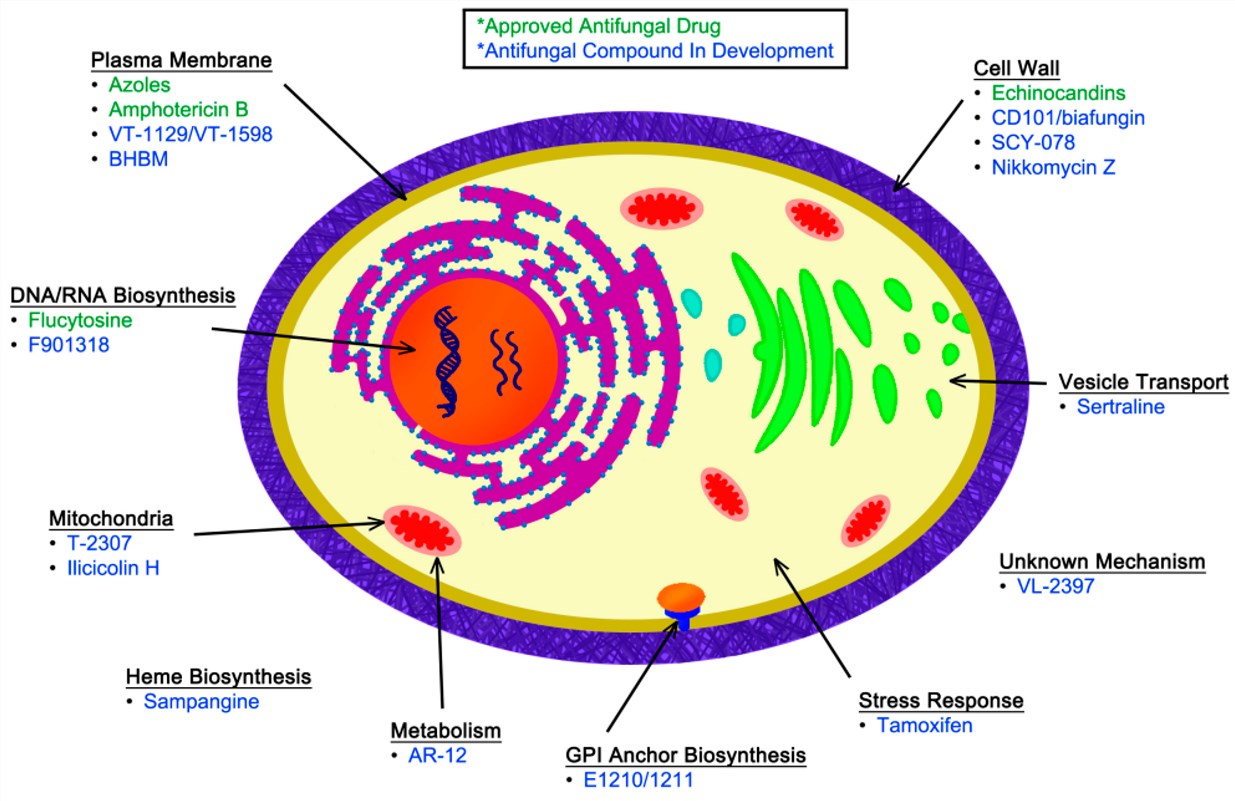Cellular Function related Targets
The incidence of invasive fungal infections caused by opportunistic fungi has been increasing steadily in recent years, frequently associated with high mortality rates. The available antifungal compounds in clinic are still very limited and often have severe side effects. Creative Biolabs combines our advanced technologies and long-term scientific expertise in the fields of antifungal drug discovery. Now we provide a series of innovative and effective targets discovery services for antifungal drugs development. Here, we focus on the introduction to cellular function-related targets.
Fungal Infections
Fungal infections in humans are commonly classified according to the affected anatomical location into superficial, cutaneous, subcutaneous, and systemic (visceral, deep-seated, or invasive) infections. Along with formidable morbidity and mortality, the incidence of invasive fungal infections has been dramatically increasing in last decades, which is probably the result of alterations in immune status associated with the acquired immunodeficiency syndrome (AIDS), cancer chemotherapy, and organ and bone marrow transplantation. Unfortunately, the repertoire of antifungal drugs is limited and many of the currently available drugs have undesirable side effects. So it is imminent to explore potential targets for antifungal drug discovery and develop new antifungal agent.
Targets Involved in Cellular Functions
Because of the remarkable similarity between fungal and mammalian metabolic and signal transduction pathways, it is a huge challenge to identify a target unique to fungi. However, several promising antifungal targets have gained wide attention. Besides the cell wall, cell membrane, nucleic acid, and protein biosynthesis and virulence factors, some other cellular functions can be recognized as antifungal drug discovery targets, mainly comprise:
-
Microtubule Aggregation
Microtubule aggregation-disaggregation plays a key role in cell morphology and growth, so the targets for microtubule aggregation will be direct and valid in antifungal drug development.
-
Signal Transduction Pathways
The signal transduction cascades in fungi participate in the whole life cycle and have become very attractive targets since their components are now emerging as potential targets for the development of new antifungal agents.
-
Rapamycin (TORs) Dependent Signaling
Rapamycin has the ability to bind to the FKBP receptor to produce a rapamycin-FKBP complex, which can block signal transduction by binding to the TOR protein. Through regulating growth and proliferation, TORs are expected to result in an effective antifungal activity.
-
Phosphoinositide 3-Kinases (PI-3-kinases)-dependent Signaling
Involved in an extraordinarily diverse group of cellular functions, including cell growth, proliferation, differentiation, motility, survival, and intracellular trafficking, PI 3-kinases have been promising targets for the development of new antifungal drugs.
-
HSP90 and HSP90-dependent Signaling
With high conservatism between yeast and humans, HSP90 and HSP90-dependent signaling cascades have become attractive antifungal drug targets.
-
Electron Transport Chain
The electron transport is important to mitochondrial function and tricarboxylic acid cycle (TCA). It has been promising targets for the development of new antifungal drugs.
-
Flavin-dependent Monooxygenase Siderophore A
It is documented that the flavin-dependent monooxygenase siderophore A (SidA) can catalyze the oxygen and NADPH dependent hydroxylation of l-ornithine (l-Orn) to N5-l-hydroxyornithine, which is important in the normal biological processes in fungi. So the targets based on SidA are expected to hold effective antifungal activity.
-
Trehalose Pathway
The trehalose pathway is not found in mammals and its enzymes in fungi should be relatively non-toxic for mammals. Therefore, the potential as a focus for antifungal targets has attracted massive attention.
-
Phosphopantetheinyl transferases
Phosphopantetheinyl transferases (PPTs) are required for the synthesis of a wide range of compounds including fatty acid, polyketide, and nonribosomal peptide metabolites. Targets for PPTs are valid in the development of new antifungal drugs.
-
Ornithine decarboxylase
The ornithine decarboxylase (ODC) enzyme catalyzes the decarboxylation of ornithine to form putrescine, which is the committed step in polyamine synthesis. ODC based antifungal targets have great potential for drug development.
 Fig.1 The sites of action for currently approved antifungal drugs.1
Fig.1 The sites of action for currently approved antifungal drugs.1
Features of Potential Targets for Antifungal Agents
- Having a broad spectrum of activity against a variety of fungi
- Be fungicidal rather than fungistatic
- Be directed at a unique fungal target and spare interference with host targets
- Having minimal side effects or toxicities
With years of experience and high-end technologies, Creative Biolabs has successfully developed various cellular function-related targets for antifungal drug discovery. We can offer high quality, reliable solutions to support our clients, and will spare no effort to advance their research and programs in antifungal drug development. Please feel free to contact us for more information.
Reference
- Pianalto, K.M.; Alspaugh, J.A. New horizons in antifungal therapy. Journal of Fungi. 2016, 2(4): 26. Distributed under Open Access license CC BY 4.0, without modification.
For Research Use Only.
